In 1998, political leaders in Northern Ireland signed a peace agreement. They hoped it would end the sectarian violence between Catholics and Protestants who’d been fighting each other for decades. At the root of the conflict, explains Far From Home reporter Scott Gurian, was the question of whether Northern Ireland should reunite with the rest of Ireland — or whether it should remain part of the United Kingdom.
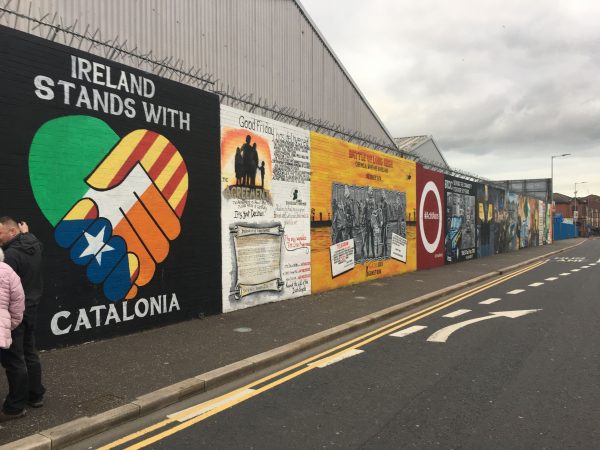
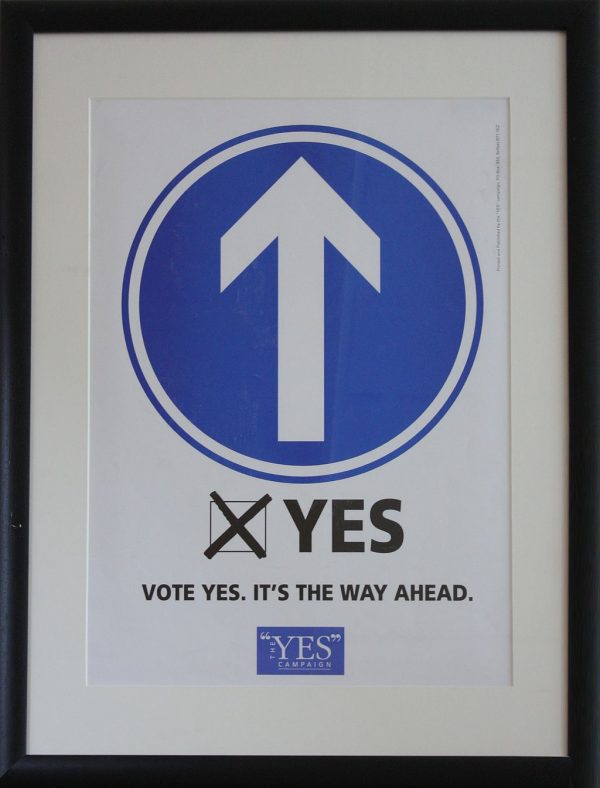
Most Catholics were nationalists — meaning they wanted to govern themselves as part of a united Ireland. Most Protestants were loyalists — also called Unionists — who felt a stronger allegiance to the British crown. Paramilitaries on both sides had carried out kidnappings, bombings, and assassinations. Thousands of people had died. The peace accord aimed to end that violence and leaders hoped it would mark the beginning of a new era.
That was more than twenty years ago. And while the political situation in Northern Ireland is certainly better today — it’s hard to say that friendship and reconciliation are the norm. Northern Ireland remains divided. In some cases, quite literally.

Protestants on the Left… Catholics on the Right
Reporter Scott Gurian is the host of the podcast Far From Home and he traveled to Northern Ireland to speak with the people directly impacted these walls. “You have a Protestant community on your left. And you have a Catholic community on your right,” says Ian McLaughlin who works with a group called the Lower Shankill Community Association. There are many walls like this in Belfast, which physically separate Protestant neighborhoods from Catholic ones. Some are fences that you can see through, while others are made of bricks and steel. Many have clearly been reinforced over time: a cinderblock wall topped with corrugated iron, then topped with razor wire, stretching up towards the sky.
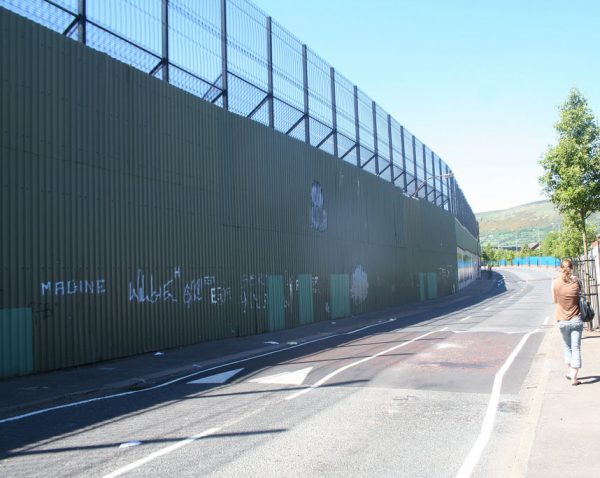
Ian McLaughlin explains that in the time before the barriers went up, violence was more frequent. “Well, I remember that you had almost a 24-hour constant military or police presence in these streets… Because at that time, the opportunity to engage in physical violence presented itself every day and every night because there was no physical barrier between people,” says McLaughlin, “so that’s why the things were created in the first instance. … To prevent physical interaction.”
Many of the walls in Northern Ireland went up in the 1970s and ‘80s at the height of what’s become known as “The Troubles.” Decades later, almost all of the walls remain standing. They cut across communities like monuments to the conflict, etched into the physical landscape. Taking them down isn’t going to be easy.
Irish Independence
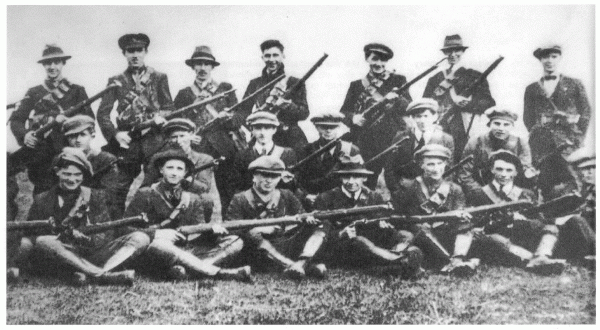
The Irish conflict goes back hundreds of years and it can be tough to pinpoint exactly when it all began, but 1922 was a pivotal year. That’s when — after decades of demands for self-governance and a bloody guerrilla war — Ireland gained its independence from the UK, with its capital in Dublin. Around the same time, the island was partitioned, with six counties in the north remaining part of the United Kingdom, forming Northern Ireland.

Protestant Loyalists were in the majority there, and they went about creating a social and political framework to make sure they remained in power. Much of the Catholic population found that framework inherently unfair and even discriminatory. “You couldn’t vote if you didn’t own your own property or business. But then you couldn’t get access to business and property … if you didn’t get access to money. And you couldn’t get access to money if you couldn’t get a job. And you couldn’t get a job… necessarily because you were a Catholic,” explains Jonny Byrne, a senior lecturer at Ulster University.
Though the two groups lived close to each other, it was like they were in totally different worlds. “I had sadly no interaction whatsoever with kids from a Catholic background,” remembers Ian McLaughlin. Protestant families sent their kids to the state-run schools, while Catholic children mostly attended schools run by the church. And each group usually lived in separate neighborhoods with people of their own kind. Protestants and Catholics could live their whole lives without really knowing anyone from the other community. This segregation meant sectarian divides just got deeper and deeper.
The Troubles
By the late ‘60s, the list of Catholic grievances had gotten pretty long. Not only were they discriminated against in employment, they didn’t have equal access to public housing and gerrymandering reduced their political influence. But their demands for change were met with strong — sometimes violent — Loyalist resistance. So after getting frustrated with the slow progress of change, they began to protest in the streets. But change wouldn’t come easily to Northern Ireland. The police responded to the marches with arrests and imprisonments, which only made the protests grow larger.
Eventually, the protests turned to riots. Which in turn sparked more riots. Especially in urban areas like Belfast, Catholics and Protestants lived right on top of each other, making the situation more explosive.
By 1969, the British military had been dispatched to Belfast to maintain order, but many people had already started taking matters into their own hands. Residents in Ian McLaughlin’s neighborhood of Shankill started building makeshift barricades between the two communities. They used burnt-out cars, construction debris, rubble from vacant houses, and basically whatever materials they could find to protect themselves from the other side.

Finally, after a summer of unrest, Northern Ireland’s Prime Minister had had enough. On September 9th, 1969, Major James Chichester-Clark went on television and made an announcement. He said the British military would erect a firm peace line between the Catholic and Protestant communities near Shankill Road. By “firm peace line” he meant that the army would dismantle the barriers the residents had built and replaced them with a more official-looking, five-foot-tall barbed wire fence. Construction began the following day.
The Shankill peace line was meant to be a strictly temporary measure. The thinking was that the barrier would give people on both sides a chance to cool down and stop the violence. One British Army major predicted that the fence would be gone by Christmas. But things didn’t go quite according to plan. Instead of being removed, that barbed wire fence was later replaced with corrugated iron sheeting that was twice as high. The army eventually added observation posts and floodlights.

Ten months later, the army put up a second iron wall between two neighborhoods in north Belfast, again insisting that it was just a temporary measure. But it turned out things were just getting started. “The whole plan was to get the communities to talk and then to start taking the walls down, but then what happened was, we normalized the policy,” Ulster University’s Jonny Byrne explains.
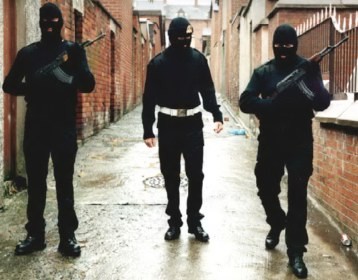
Over the next three decades of the Troubles, the fighting intensified. Both Catholic groups like the Irish Republican Army and Loyalist paramilitary organizations like the Ulster Volunteer Force carried out high-profile bombings and assassinations. The neighborhoods beset by the worst violence were strewn with rubble and patrolled by men in face-masks, toting rifles. As violence continued, the government, as well as private landowners, constructed close to 100 additional walls in cities across Northern Ireland.
A Part of the Landscape
The walls took various forms over the years. Some were just tall fences, while others were built with concrete, bricks, and mortar — far from the temporary structures that officials had originally promised. Occasionally, they were painted or covered with hedges to make them look more attractive. One of those walls even ran through the center of a city park in Duncairn, a formerly dangerous neighborhood in north Belfast.
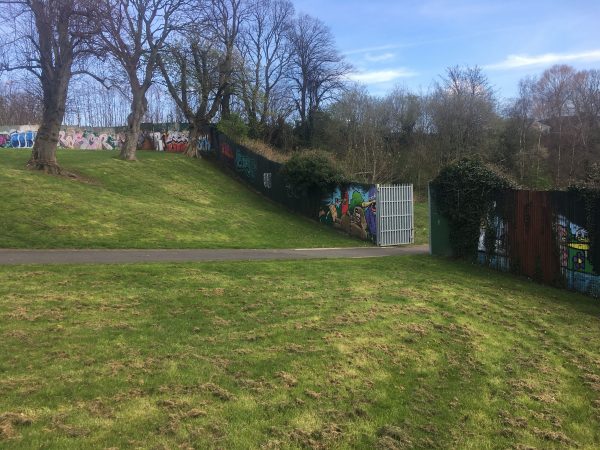
Finally, in 1994 it seemed that all the violence and wall-building might subside. The Provisional Irish Republican Army released a statement agreeing to lay down their weapons. They promised to shift their tactics to political negotiation. The announcement was met with a mix of skepticism and celebration. Many people in Northern Ireland saw it as a historic development.
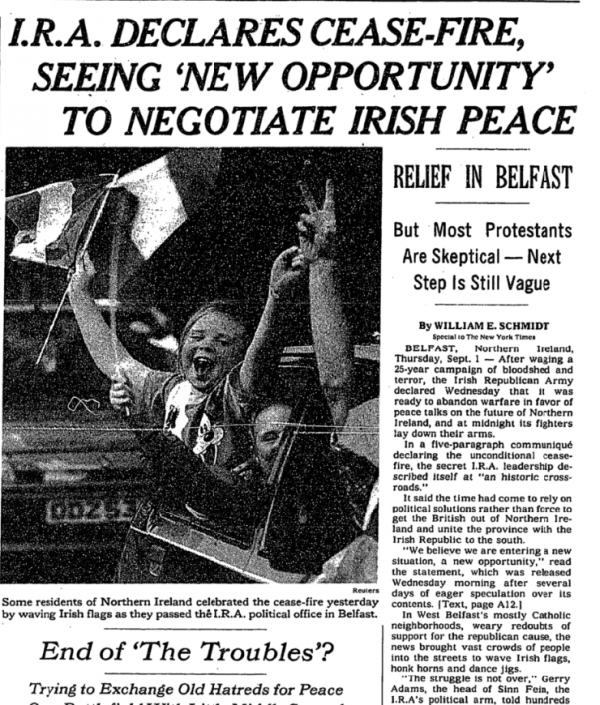
But despite the announcement of a ceasefire, walls continued going up. Just because organizations like the IRA had declared a ceasefire, the conflict at the street level went on.
A few years later, in 1998, the Troubles officially ended with the signing of the peace agreement. But that didn’t stop even more fences and walls from going up. At the interfaces between Protestant and Catholic communities, the same old tensions remained. The most recent fence was built in 2013.
Should They Stay or Should They Go?
Eventually, the government enacted an official policy of wall removal. They even set a target of 2023. But when you talk to people on the ground, there seems to be widespread agreement that the target is completely unrealistic. And it’s not even clear if most people want the walls to come down.
Geraldine O’Kane works for an organization — called Greater Whitewell Community Surgery — that’s trying to build bridges between young people from Protestant and Catholic backgrounds. The whole idea, she says, is that it’s hard to throw a stone at a friend. But her work has sometimes made her a target. In 2013, someone snuck into the building where she works with kids and left an explosive device in the courtyard. A bomb disposal team got rid of it. Ultimately, O’Kane says that the decision about whether the walls should stay or go needs to be made by the people who live closest to them and are most directly impacted by the violence. Ian McLaughlin agrees. He knows that in a lot of neighborhoods the idea of removing walls is unpopular. But he thinks it’s possible, if people move slowly and deliberately, and get community input at each stage in the process. “Is there going to be a play area created for kids? Is there going to be work opportunities for young people to take part in it? All those thoughts have to come into the equation,” says McLaughlin.But even if it’s slow, McLaughlin wants the walls to come down. He thinks it’s a moral imperative. Because there are new generations of kids growing up around these structures, and he wonders what ideas they are absorbing from them. “Kids being the most inquisitive little people are going to say, ‘Daddy, Mommy… Why is that wall there?'” he says. “In this community, you may well be told, ‘That wall was put there to stop Catholics from attacking your home.’ And on the other side of the gate, a child may be told, ‘Oh, that wall was put there to stop Protestants from attacking your home.'”
“We are creating the seeds of sectarianism in kids for another generation. How it manifests itself in another generation’s time is anybody’s guess,” he says.



Comments (6)
Share
Great episode. There’s a history behind “Protestants like soup” comment. Compared to the other trivial (hilarious) differences.
https://en.m.wikipedia.org/wiki/Souperism
Another fascinating episode. Brexit continues to be the worst idea right-wing pensioners ever came up with. Always disappointing how much hatred and strife is caused by people arguing over their imaginary friends.
I am a centralist young adult with a postgrad education and support Brexit. Nice try though making it about the ‘old right’.
This is a very good brief listen to the Belfast problem. Last week I was on an ‘Urban Planning summer scheme’ here in belfast and ‘interfaces’ were our focal point. It was interesting listening to these issue as heard by and outsider and the view on Belfast. These issues though are not belfast centric and widely cover all of the country. The ‘peace lines’ are the physical, but here in Northern Ireland when you go into the rural areas you move into the ‘invisible’ lines. In fermanagh it turns into what village do are you from, where in a town are you from, what school, what doctors, dentists or shops. It truly becomes invisible.
You stated in the podcast ‘we all look the same’ and to outsiders this is correct. However when you live here and you have a keen eye you can tell roughly what background someone is by the way they look or dress, this again is when it turns invisible. It even goes into dating apps, facebook pages and instagram posts.
A fantastic episode, bad this is coming from someone who was born and bred in Northern Ireland only 20 miles from Belfast. This does a great job of explaining the extremely complex situation here. This stuff is taught in almost every school here. I myself was on a “field trip” to the peace walls were each person was allowed to write an open message on the wall.
Anyways fantastic episode from a fantastic podcast.
Very good episode! It was a bit bizarre listening to this while walking home from work in Belfast city centre, looking around and seeing the areas that are being spoken about. Often reporting about Northern Ireland can feel patronising (“why can’t those people get along?!”) and forget or decide to not include the voices from our community, so thank you for including Belfast voices, who represented us proudly, in your piece.